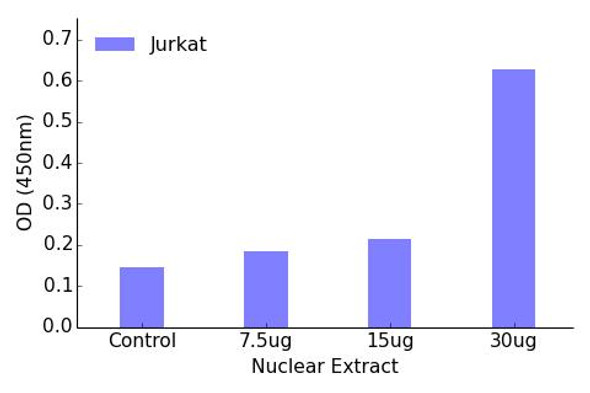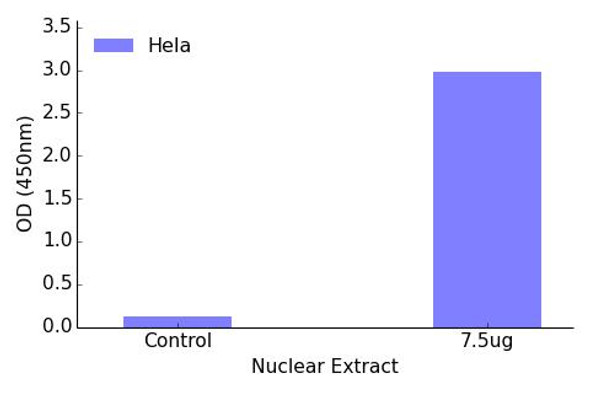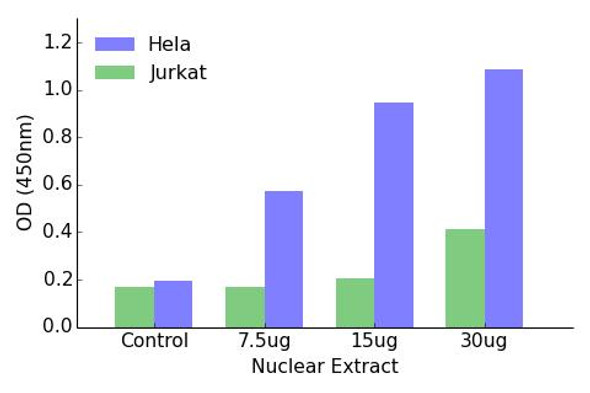Description
HOXA1 Transcription Factor Activity Assay
The HOXA1 Transcription Factor Activity Assay Kit is a comprehensive solution for studying the transcriptional activity of the HOXA1 protein in biological samples. This kit is specifically designed for researchers looking to investigate the role of HOXA1 in gene expression regulation and its impact on various cellular processes.With its high sensitivity and specificity, the HOXA1 Transcription Factor Activity Assay Kit provides accurate and reliable results, allowing for precise measurements of HOXA1 activity in a variety of sample types. This kit is ideal for a wide range of research applications, including studies on developmental biology, cancer research, and neurological disorders.
HOXA1 is a key transcription factor that plays a critical role in regulating gene expression patterns and controlling cell differentiation and development. Dysregulation of HOXA1 has been implicated in various diseases, making it an important target for therapeutic interventions and biomarker discovery.Overall, the HOXA1 Transcription Factor Activity Assay Kit offers researchers a valuable tool for investigating the function of HOXA1 and its potential implications in disease pathology, ultimately advancing our understanding of gene regulation mechanisms and identifying novel therapeutic targets.
| Product Name: | HOXA1 Transcription Factor Activity Assay |
| Product Code: | TFAB00121 |
| Target: | HOXA1 |
| Synonyms: | Homeobox protein Hox-1F |
| Reactivity: | Human, Mouse, Rat |
| Sample Types: | Nuclear or cell lysates |
The Assay Genie HOXA1 transcription factor activity assay allows for the detection and qualitative analysis of endogenous levels of activated transcription factors in a variety of nuclear and cell lysates
Assay Genie ELISA kits are designed to significantly reduce experiment time and ensure sensitivity and flexibility for high-throughput screening.
| Assay Time: | 4.5 hours |
| Detection Method: | Colorimetric 450 nm |
| Size: | 12 x 8-Well Microstrips |
| Storage: | 4°C for 6 months |
| UniProt Protein Function: | HOXA1: Sequence-specific transcription factor which is part of a developmental regulatory system that provides cells with specific positional identities on the anterior-posterior axis. Acts on the anterior body structures. Seems to act in the maintenance and/or generation of hindbrain segments. Defects in HOXA1 are the cause of Athabaskan brainstem dysgenesis syndrome (ABDS); also known as Narvajo brainstem syndrome. This syndrome is characterized by horizontal gaze palsy, sensorineural deafness, central hypoventilation, and developmental delay. Some patients had swallowing dysfunction, vocal cord paralysis, facial paresis, seizures, and cardiac outflow tract anomalies. Defects in HOXA1 are the cause of Bosley-Salih-Alorainy syndrome (BSAS). Affected individuals show horizontal gaze abnormalities, deafness, facial weakness, vascular malformations of the internal carotid arteries and cardiac outflow trac. Some patients manifest mental retardation and autism spectrum disorder. In contrast to individuals with ABSD, central hypoventilation is not observed in individuals with BSAS. Belongs to the Antp homeobox family. Labial subfamily. 3 isoforms of the human protein are produced by alternative splicing. |
| UniProt Protein Details: | Protein type:Oncoprotein; DNA-binding; Transcription factor Chromosomal Location of Human Ortholog: 7p15.3 Molecular Function:protein binding Biological Process: abducens nerve formation; anatomical structure morphogenesis; artery morphogenesis; cognition; embryonic neurocranium morphogenesis; inner ear development; multicellular organismal development; neuromuscular process; optokinetic behavior; outer ear morphogenesis; regulation of behavior; sensory perception of sound Disease: Athabaskan Brainstem Dysgenesis Syndrome |
| NCBI Summary: | In vertebrates, the genes encoding the class of transcription factors called homeobox genes are found in clusters named A, B, C, and D on four separate chromosomes. Expression of these proteins is spatially and temporally regulated during embryonic development. This gene is part of the A cluster on chromosome 7 and encodes a DNA-binding transcription factor which may regulate gene expression, morphogenesis, and differentiation. The encoded protein may be involved in the placement of hindbrain segments in the proper location along the anterior-posterior axis during development. Two transcript variants encoding two different isoforms have been found for this gene, with only one of the isoforms containing the homeodomain region. [provided by RefSeq, Jul 2008] |
| UniProt Code: | P49639 |
| NCBI GenInfo Identifier: | 6166216 |
| NCBI Gene ID: | 3198 |
| NCBI Accession: | P49639.2 |
| UniProt Secondary Accession: | P49639,O43363, A4D184, B2R8U7, |
| UniProt Related Accession: | P49639 |
| Molecular Weight: | 24,489 Da |
| NCBI Full Name: | Homeobox protein Hox-A1 |
| NCBI Synonym Full Names: | homeobox A1 |
| NCBI Official Symbol: | HOXA1 |
| NCBI Official Synonym Symbols: | BSAS; HOX1; HOX1F |
| NCBI Protein Information: | homeobox protein Hox-A1 |
| UniProt Protein Name: | Homeobox protein Hox-A1 |
| UniProt Synonym Protein Names: | Homeobox protein Hox-1F |
| Protein Family: | Homeobox protein |
| UniProt Gene Name: | HOXA1 |
| UniProt Entry Name: | HXA1_HUMAN |






